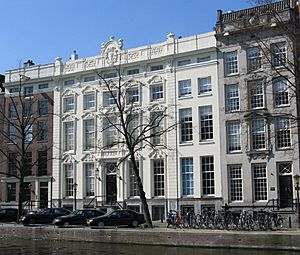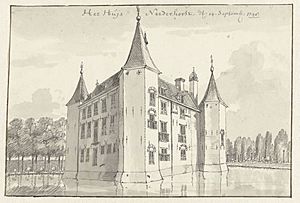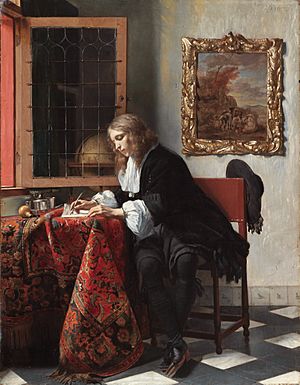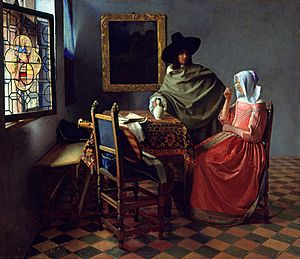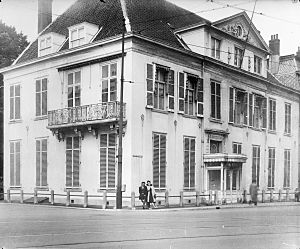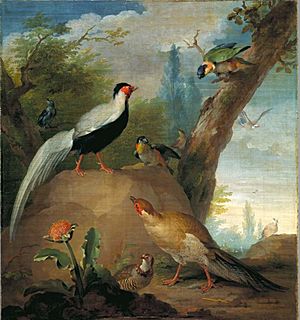Jan Hope facts for kids
John Hope (born February 14, 1737 – died April 20, 1784) was a very rich Dutch banker. He was part of a famous banking family called Hope & Co.. John was also a member of the city council and loved collecting art. In 1770, he became a manager for the Dutch East India Company (VOC), which was a huge trading company.
Today, John Hope is also known for his beautiful Groenendaal Park in Heemstede. This was his summer home. Just before he passed away, he bought another nearby estate called "Bosbeek." This estate became one of the first big gardens in the 'English Style' in the Netherlands. His second son, Adrian Elias, helped shape this garden. John's oldest son, Thomas Hope, became famous for designing neoclassical interiors. His youngest son, Henry Philip Hope, was a gem collector and jewelry expert. He even owned the legendary Hope Diamond!
Contents
Early Life and Family
John Hope was an only child. He was born in Amsterdam into the wealthy Hope family, who were involved in trading, shipping, and banking. His parents were Thomas Hope and Margaretha Marcelis. John was first baptized as Jan in a Mennonite church. When he was 19, he chose to be re-baptized as John in the Presbyterian church.
John likely studied law. In 1760, he went on a "Grand Tour" to Italy with his cousin Oliver. During this trip, he bought 24 drawings by Antonio Visentini. In Venice, he met James Watt, a famous inventor. In 1761, John bought a fancy mantelpiece designed by Piranesi.
In 1762, John and his cousin Henry Hope were invited to join the board of Hope & Co.. John was traveling at the time, so he didn't sign right away. In 1763, he married Philippina Barbara van der Hoeven. She was the daughter of a mayor from Rotterdam and also loved art. Together with John's uncle Adrian, they started the famous Hope Collection of Pictures.
John was a member of the Amsterdam city council from 1768 to 1777. He was also a director of the Dutch Society of Science. John was very interested in the new ideas of the Scottish enlightenment, unlike his cousin Henry. In 1774, he bought the castle Nederhorst, which came with a special title. His sons later inherited it, but they didn't use or change the castle and its park much.
Banking and Art Collecting
In 1766, John's father, Thomas, became a personal advisor to the stadtholder William V. He represented the stadtholder in all the important meetings of the VOC. In 1767, the Hope bank worked with Sir Joshua Vanneck, 1st Baronet and his son. Around this time, John bought Groenendaal near Heemstede.
In 1770, John was appointed as one of the managers, known as the Heren XVII, of the VOC. This happened after his father retired due to a stroke. The Hope Company also worked with other big companies like Alexander Fordyce and Harman and Co.
John lived and worked in the Hope & Co. banking offices in Amsterdam. However, he was more interested in his estates, his title, and showing off his wealth. His cousin Henry let him expand their shared art collection. This collection was used to impress important clients, often leaders from other countries. John Hope owned many tables made of different types of stone. Some of these stones were even dug up when he was present at the Villa Hadriana in Tivoli, Italy.
In 1771, the company bought a wonderful collection of paintings from two brothers in Rotterdam. In 1779, John inherited half of the company from his father. In 1780-1782, the company lent a huge amount of money to King Gustav III of Sweden and King Charles III of Spain. John Hope bought the biggest mansion on Herengracht (numbers 509-511) in Amsterdam. His family also gained 25% of the shares in a porcelain factory started by Joannes de Mol. From 1774 to 1782, he represented Amsterdam in the States of Holland in The Hague. In 1784, he bought "Bosbeek." He passed away at Korte Voorhout. After his death, his family moved to Heemstede.
Developing Parks
John and Philippina had three sons: Thomas Hope (1769–1831), Adrian Elias (1772-1834), and Henry Philip Hope (1774-1839). His son Adrian Elias made Groenendaal Park even more beautiful. He built the Belvedere, a tower that stood for a century on a hill. He also built the "Walvisbank," a park bench made from whale bones. You can see both of these in old postcards of Groenendaal park.
John and his cousin Henry Hope were responsible for creating Groenendaal in Heemstede and the Haarlemmerhout in Haarlem. These were the two largest city parks in the area. The boys were raised by their mother, Philippina. She kept the Heemstede property and welcomed visitors to see the gardens with their many interesting features and her large art collection.
When Henry Hope had to leave the country in 1794-1795, he took the young men and about 370 paintings with him. The Heemstede and Haarlem estates, along with the Amsterdam banking office, were left in the care of John Williams Hope. In 1802, only Adrian Elias returned to the Netherlands. He spent the rest of his life working on the gardens of Groenendaal and Bosbeek.
The First Garden Steam Engine
John Hope saw a "fire engine" (an early steam engine) at Leiden University. He then wrote to James Watt and Matthew Boulton, who were famous for their steam engines. John had his own "fire machine," which was the first steam engine used for a garden, installed at his summer home.
His park was on a high, sandy ridge of dunes between the Leidsevaart canal and Harlem Lake. He used the steam engine to pump water into his gardens. This was very unusual because most people in the Netherlands at that time were trying to pump water out of places! John had a windmill before, but it couldn't provide enough water on days without wind for his richly planted English-style garden.
The steam engine was installed in 1781. It worked for many years, even after the French occupation, until the 1820s. In 1842, it was taken apart. By then, it couldn't compete with the much larger steam boiler of the Cruquius pumping station nearby.
Sources
- John Hope in the Vroedschap van Amsterdam (1578–1795), by Johan Engelbert Elias, Volume 2, 1905, Amsterdam, on historici.nl
- Groenendaal. Albumuitgave van de Vereniging Oud-Heemstede-Bennebroek (VOHB), 1978.
- Hans Krol. Geschiedenis van het buitengoed Bosbeek en van het adellijk geslacht Van Merlen. Heemstede, VOHB, 1987.


